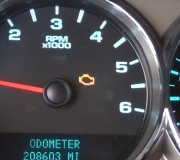When I did research, I discovered that the most likely cause is the thermostat, so I replaced the thermostat.
It was a difficult task in this vehicle but the check engine light went away and everything was going great until I noticed that when I turn off the car, wait a couple of minutes then turn the key enough to light up the instrument lights the temperature gauge was reading 3/4 of the way to hot.
When I plugged in my OBD2 Code reader and used Torque It said the coolant was 240 degrees.
The thing is when I start the engine the temperature drops back to normal the entire time I'm driving or sitting at a light it only seems to overheat when the engine is off.
I did more research and thought there might be air in the coolant system because of the thermostat replacement.
I bought a funnel kit to bleed the cooling system and get the air out but that didn't work.
I'm really not sure what my next course of action should be, I thought about replacing the temperature sensor, but I don't want to waste money I might need if it turns out to be something else.
Any suggestions would be great, and thanks so much in advance for your help
Stewart
SPONSORED LINKS
Monday, January 8th, 2024 AT 2:03 PM



